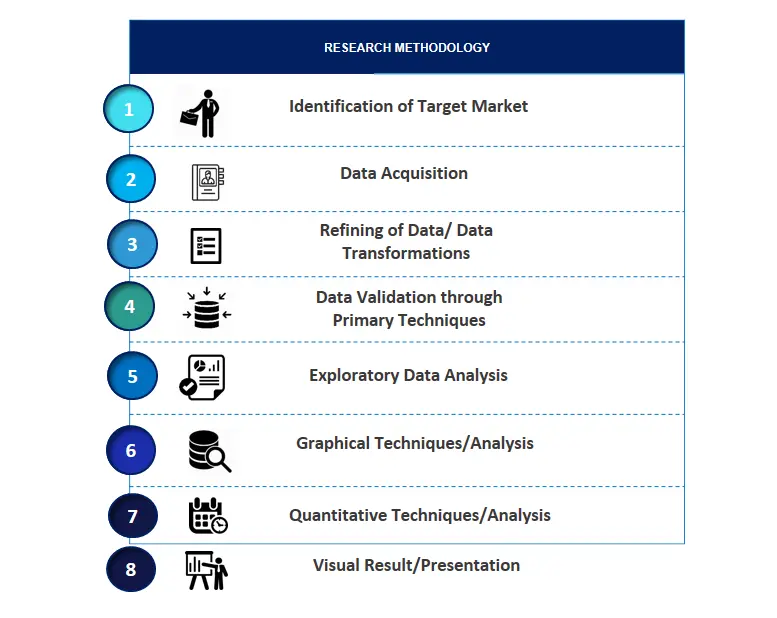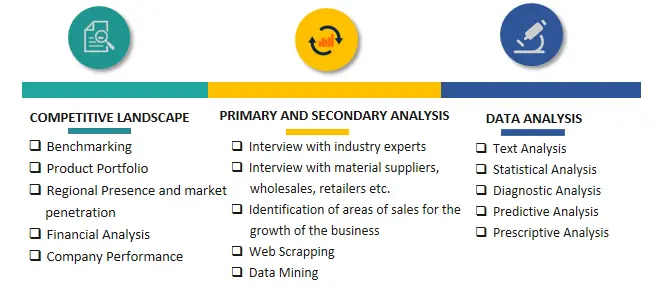
Industrial Food Cutting Machines Market Trends, Share, Size, Demand, Revenue and Future Outlook
Industrial Food Cutting Machines Market Growth, Size, Trends Analysis- By Technology, By Application - Regional Outlook, Competitive Strategies and Segment Forecast to 2033
| Published: Dec-2024 | Report ID: MACH2445 | Pages: 1 - 248 | Formats*: |
| Category : Equipment and Machinery | |||
- In June 2022, JBT unveiled the SuperCRss Retort System, a cutting-edge saturated steam sterilization system with reliable and time-saving automation features. In addition to processing a wide range of materials, this system incorporates JBT's processing management system, LOG-TECTM, which guarantees consistency in product quality.
- In November 2023, JBT developed DSI water-jet portioners, which are now used globally in the meat, poultry, seafood, and pet food industries. Products such as poultry parts, fillets, steaks, medallions, strips, nuggets, and even intricate shapes can be produced using these machines.


| Report Metric | Details |
| Market size available for years | 2020-2033 |
| Base year considered | 2023 |
| Forecast period | 2024-2033 |
| Segments covered | By Technology, By Application |
| Regions covered | North America, Asia-Pacific, Latin America, Middle East & Africa and Europe |
| Companies Covered | Bühler AG, FAM N.V., GEA Group AG, Grote Company, Holac Maschinenbau GmbH, JBT Corporation, Marel, Treif Maschinenbau GmbH, Urschel Laboratories, WEBER Maschinenbau GmbH. |
- Food Processing Companies
- Commercial Foodservice Providers
- Food Packaging Manufacturers
- Supermarkets and Retail Chains
- Food Manufacturers and Suppliers
- Equipment Distributors and Resellers
- Automation and Robotics Firms
| By Technology: | |
| By Application: |
- Global Industrial Food Cutting Machines Market Size (FY’2024-FY’2033)
- Overview of Global Industrial Food Cutting Machines Market
- Segmentation of Global Industrial Food Cutting Machines Market By Technology (Automatic, Semi-Automatic, Manual)
- Segmentation of Global Industrial Food Cutting Machines Market By Application (Cheese, Meat, Fruits and Vegetables, Others)
- Statistical Snap of Global Industrial Food Cutting Machines Market
- Expansion Analysis of Global Industrial Food Cutting Machines Market
- Problems and Obstacles in Global Industrial Food Cutting Machines Market
- Competitive Landscape in the Global Industrial Food Cutting Machines Market
- Impact of COVID-19 and Demonetization on Global Industrial Food Cutting Machines Market
- Details on Current Investment in Global Industrial Food Cutting Machines Market
- Competitive Analysis of Global Industrial Food Cutting Machines Market
- Prominent Players in the Global Industrial Food Cutting Machines Market
- SWOT Analysis of Global Industrial Food Cutting Machines Market
- Global Industrial Food Cutting Machines Market Future Outlook and Projections (FY’2024-FY’2033)
- Recommendations from Analyst
1.1. Scope of the report1.2. Market segment analysis
2.1. Research data source2.1.1. Secondary Data2.1.2. Primary Data2.1.3. SPER’s internal database2.1.4. Premium insight from KOL’s2.2. Market size estimation2.2.1. Top-down and Bottom-up approach2.3. Data triangulation
4.1. Driver, Restraint, Opportunity and Challenges analysis4.1.1. Drivers4.1.2. Restraints4.1.3. Opportunities4.1.4. Challenges4.2. COVID-19 Impacts of the Global Industrial Food Cutting Machines Market.
5.1. SWOT Analysis5.1.1. Strengths5.1.2. Weaknesses5.1.3. Opportunities5.1.4. Threats5.2. PESTEL Analysis5.2.1. Political Landscape5.2.2. Economic Landscape5.2.3. Social Landscape5.2.4. Technological Landscape5.2.5. Environmental Landscape5.2.6. Legal Landscape5.3. PORTER’s Five Forces5.3.1. Bargaining power of suppliers5.3.2. Bargaining power of buyers5.3.3. Threat of Substitute5.3.4. Threat of new entrant5.3.5. Competitive rivalry5.4. Heat Map Analysis
6.1. Global Industrial Food Cutting Machines Market Manufacturing Base Distribution, Sales Area, Product Type6.2. Mergers & Acquisitions, Partnerships, Product Launch, and Collaboration in Global Industrial Food Cutting Machines Market
7.1. Global Industrial Food Cutting Machines Market Size, Share and Forecast, By Technology, 2020-20267.2. Global Industrial Food Cutting Machines Market Size, Share and Forecast, By Technology, 2027-20337.3. Automatic7.4. Semi-Automatic7.5. Manual
8.1. Global Industrial Food Cutting Machines Market Size, Share and Forecast, By Application, 2020-20268.2. Global Industrial Food Cutting Machines Market Size, Share and Forecast, By Application, 2027-20338.3. Cheese8.4. Meat8.5. Fruits and Vegetables8.6. Others
9.1. Global Industrial Food Cutting Machines Market Size and Market Share
10.1. Global Industrial Food Cutting Machines Market Size and Market Share By Region (2020-2026)10.2. Global Industrial Food Cutting Machines Market Size and Market Share By Region (2027-2033)10.3. Asia-Pacific10.3.1. Australia10.3.2. China10.3.3. India10.3.4. Japan10.3.5. South Korea10.3.6. Rest of Asia-Pacific10.4. Europe10.4.1. France10.4.2. Germany10.4.3. Italy10.4.4. Spain10.4.5. United Kingdom10.4.6. Rest of Europe10.5. Middle East and Africa10.5.1. Kingdom of Saudi Arabia10.5.2. United Arab Emirates10.5.3. Qatar10.5.4. South Africa10.5.5. Egypt10.5.6. Morocco10.5.7. Nigeria10.5.8. Rest of Middle-East and Africa10.6. North America10.6.1. Canada10.6.2. Mexico10.6.3. United States10.7. Latin America10.7.1. Argentina10.7.2. Brazil10.7.3. Rest of Latin America
11.1. Bühler AG11.1.1. Company details11.1.2. Financial outlook11.1.3. Product summary11.1.4. Recent developments11.2. FAM N.V.11.2.1. Company details11.2.2. Financial outlook11.2.3. Product summary11.2.4. Recent developments11.3. GEA Group AG11.3.1. Company details11.3.2. Financial outlook11.3.3. Product summary11.3.4. Recent developments11.4. Grote Company11.4.1. Company details11.4.2. Financial outlook11.4.3. Product summary11.4.4. Recent developments11.5. Holac Maschinenbau GmbH11.5.1. Company details11.5.2. Financial outlook11.5.3. Product summary11.5.4. Recent developments11.6. JBT Corporation11.6.1. Company details11.6.2. Financial outlook11.6.3. Product summary11.6.4. Recent developments11.7. Marel11.7.1. Company details11.7.2. Financial outlook11.7.3. Product summary11.7.4. Recent developments11.8. Treif Maschinenbau GmbH11.8.1. Company details11.8.2. Financial outlook11.8.3. Product summary11.8.4. Recent developments11.9. Urschel Laboratories11.9.1. Company details11.9.2. Financial outlook11.9.3. Product summary11.9.4. Recent developments11.10. WEBER Maschinenbau GmbH11.10.1. Company details11.10.2. Financial outlook11.10.3. Product summary11.10.4. Recent developments11.11. Others
SPER Market Research’s methodology uses great emphasis on primary research to ensure that the market intelligence insights are up to date, reliable and accurate. Primary interviews are done with players involved in each phase of a supply chain to analyze the market forecasting. The secondary research method is used to help you fully understand how the future markets and the spending patterns look likes.
The report is based on in-depth qualitative and quantitative analysis of the Product Market. The quantitative analysis involves the application of various projection and sampling techniques. The qualitative analysis involves primary interviews, surveys, and vendor briefings. The data gathered as a result of these processes are validated through experts opinion. Our research methodology entails an ideal mixture of primary and secondary initiatives.



Frequently Asked Questions About This Report
PLACE AN ORDER
Year End Discount
Sample Report
Pre-Purchase Inquiry
NEED CUSTOMIZATION?
Request CustomizationCALL OR EMAIL US
100% Secure Payment






Related Reports
Our Global Clients
Our data-driven insights have influenced the strategy of 200+ reputed companies across the globe.




















